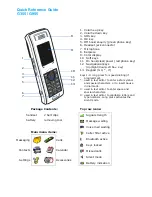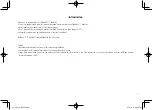
42
To reply to a message
1
When you have read the message
}
YES
.
2
}
}
YES
.
3
Select the message you want to send as a reply
}
YES
.
or
a template if available.
4
Write your message
}
YES
.
To forward a message
1
When you have read the message
}
YES
.
2
}
}
YES
. Continue in the same way as when
sending a new text message.
To call a phone number found in a message
When the number is highlighted
}
YES
.
To call the sender of the message
1
When you have read the message
}
YES
.
2
}
}
YES
.
To delete a message
When you have read the message
}
YES
}
}
YES
.
Saving incoming messages
Text messages are automatically saved in the phone memory.
When the phone memory is full, they are automatically saved
on the SIM card. When both phone memory and SIM card
memory are full, you must delete messages to be able to
receive new messages. Messages that you have saved on the
SIM card can remain there until you have deleted them.
To save a message on the SIM card
When you have read the message
}
YES
}
}
YES
.
This is the Internet version of the user's guide. © Print only for private use.
Contents
1
Contents
Getting to know your phone 4
Key functions, quick keys, entering letters and characters.
Personalizing your phone 22
Download settings or choose from the phone.
Calling 31
Use the Phonebook, voice control, call options.
Messaging 51
Multimedia messaging, chat and e-mail.
Camera 60
Use the camera.
Setting up WAP and e-mail 63
All you need to know about setting up WAP and e-mail.
Using WAP 71
WAP browser, bookmarks.
Transferring and exchanging information 74
Bluetooth
wireless technology, synchronization.
More features 79
Calendar, alarm clock, stopwatch, timer, games.
Security 87
SIM card lock, phone lock.
Troubleshooting 89
Why doesn’t the phone work the way I want?
Additional information 91
Safe and efficient use, warranty, declaration of conformity.
Icons 98
What do the icons mean?
Index 105
Sony Ericsson T618
















































